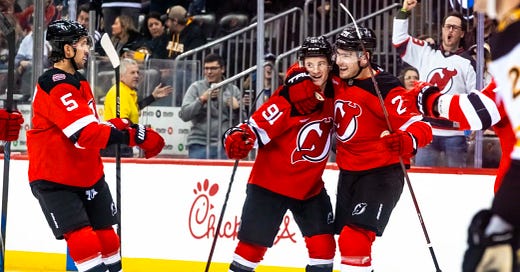New-Look Devils Get Back To Familiar Execution
The so-called “line blender” is typically the last bastion of a desperate hockey team. A coach will shuffle around his forward units, maybe some defense pairings too, and then pray that he can catch lightning in a bottle. For if that doesn’t work, harsher panic moves could be in order, like trades or, heaven forbid, a coaching change.
The Devils, 2-6-3 in their previous 11 games heading into Wednesday night’s home tilt versus Boston, could no longer sit still while the points cushion from their excellent start to the season was eroding away. So in advance of the contest, Head Coach Sheldon Keefe erased the 12 forwards on his board and started over.
Keefe spilt top two scorers Jack Hughes and Jesper Bratt, putting a pair of bottom-six guys (Nathan Bastian and Paul Cotter) with Hughes while Bratt skated with Nico Hischier and Stefan Noesen. That sent Timo Meier down to the third line with Dawson Mercer and Justin Dowling.
Before we all hail Keefe for being a genius because the Devils responded to the changes with a 5-1 victory, let’s understand that the theory, A followed B; therefore B caused A, is bunk. It took New Jersey’s skaters a period to get used to their swapped linemates, with Bratt committing an egregious giveaway to gift Boston an early 1-0 lead.
The Devils generally looked as hesitant as they have been since the Christmas break, when they boasted the third-best points percentage in the league. During this slump, however, fans could feel in their gut the squeeze from the tightening grips on Devils’ sticks caused by constant failures to convert on scoring chances. The club’s 7.7% shooting percentage since December 28 placed them 30th among the league’s 32 teams.
The turning point, as it so often does in this wacky game, came off a fortuitous bounce early in the second period. A Meier centering pass from the left circle was deflected into the slot, where Mercer spun around and whipped the puck past Bruins goalie Jeremy Swayman.
Was the Meier switch the catalyst, or was this a play where the percentages finally went the Devils’ way after so many of the similar opportunities this month were shot wide or into the opposing goalie’s midsection?
From there, the Devils power play, which was also in a puzzling funk but went untouched by Keefe, took over, scoring three goals in their last six opportunities. Again, I wouldn’t say the Devils did things all that differently from the previous 11 games when they went a meek 4-for-26 (15.4%) with the man advantage. It was just that pucks suddenly found sticks in the right spots and shooters didn’t miss.
The only goal that showed off any intriguing newfound chemistry was Mercer’s second of the night 12 seconds after Noesen’s power play stuffer. Meier won a puck battle behind the net and got it to Dowling to the right of the cage. Dowling then one-touched it to an unmarked Mercer in front for a 4-1 lead with 3:47 remaining in the second period. Perfect execution.
That trio also initiated a sequence earlier in that frame following a successful Devils penalty kill where the Bruins were hemmed in their own half of the ice for about three minutes, hobbled by the period’s long change. In fairness, the best Devils chances came after Keefe was able to circulate his star trio of Hischier, Hughes, and Bratt on the fly, which is something he saves for these types of circumstances.
What was most impressive about this Devils win was how they stuck to their system when they might have ordinarily looked to make high-risk plays to entertain a raucous crowd juiced up by the star-laden pregame ceremony that inducted former Stanley Cup-winning Head Coach Jacques Lemaire into their Ring of Honor. In addition, they didn’t allow the second period injury that forced goalie Jacob Markstrom to exit throw them off; backup Jake Allen stepped in to save all 16 shots he saw to earn his first victory since November 23.
This was how the Devils played for most of the season’s first half. They thrived despite top-heavy scoring by dominating the special teams, suppressing shots, and getting above average goaltending. When the top guns dried up, especially on the power play, the team’s margin for error was breached and every mistake snowballed into an avalanche. It wasn’t rocket science that required a formula revision. It was all about the execution.
As for the statistical impact of the new line blends, the underlying data was mixed. While the revised third line certainly tilted the ice in the Devils’ favor, the Hischier and Hughes lines had sub-50% expected goals for percentage shares at five-on-five, per NaturalStatTrick.com. I’m dubious that continuing to play two muckers with Hughes will unlock more five-on-five scoring in total. It’s more likely that you’ll be seeing Hughes feeling forced to attempt to create chances by himself, which is not how you should want to use your most skilled player. The old line that a fire hydrant could score 20 goals playing with Wayne Gretzky was a myth.
Oh, as for the fourth line of Curtis Lazar, Tomas Tatar, and Kurtis MacDermid, they played a mere 3:55 together on Wednesday night. That trio’s expected goals for percentage? 6.8%, so nothing’s changed from their prior “unplayable” status.
The Devils are off until their visit to Montreal on Saturday. Expect Keefe to make more tweaks when wing Ondrej Palat gets over his illness and center Erik Haula is cleared to return from his ankle injury. By then we might see a return to the familiar blend.



